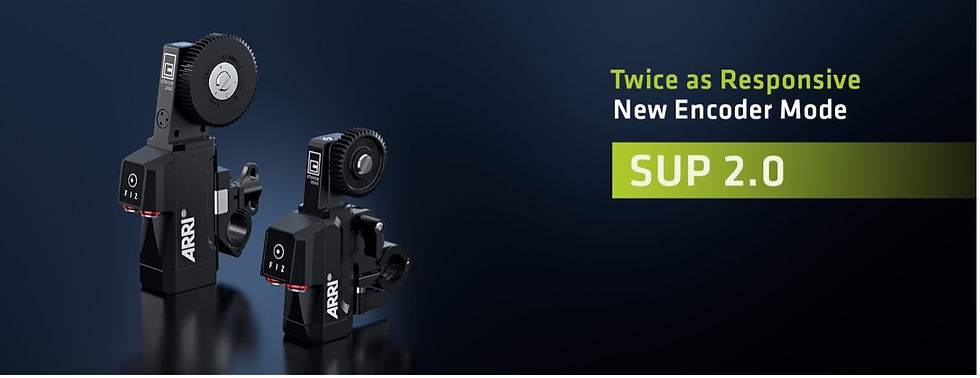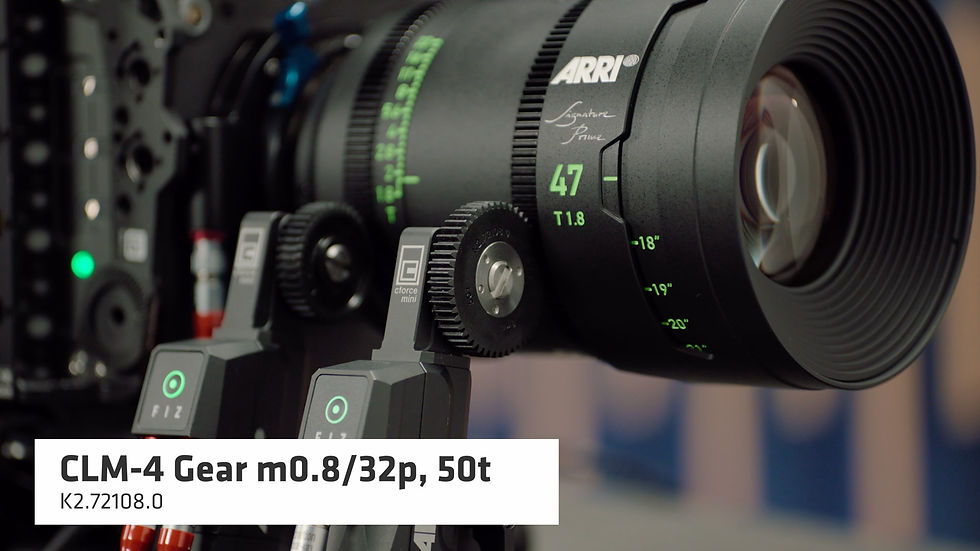Twice as Responsive & Encoder ModeSUP 2.0 for cforce mini + plus
- Sean Dooley
- Aug 3, 2023
- 4 min read

Today we’re introducing a big change to how the cforce mini and the cforce plus lens motors behave with all ARRI and cmotion lens control systems. We’ve made both motors twice as responsive – basically halving the time that it takes for motors to start moving once you adjust the focus knob. And, we’ve introduced Encoder Mode, which lets you use cforce mini motors as dedicated lens encoders, allowing manual iris inputs while still keeping all lens data functional, for example.

Twice as Responsive
In this frame grab, two cforce mini motors are being controlled by the same focus knob. This isn’t a feature we’re planning on introducing, but rather a special way to compare the response times between lens motors running the new SUP 2.0 firmware (left), and the older version (right). With the new firmware (left), you can see is already moving in response to my focus adjustment, while the motor on the right remains stationary. This new behavior really feels different. The first time I found out about the new firmware, Tobias, ARRI’s ECS Product Manager, had installed a beta version of SUP 2.0 onto one of the mini motors on display at Cine Gear, and hadn’t told me about the changes. He was absent mindedly racking focus while we were talking about something else, and I had to stop him to ask if he had secretly brought a new motor along with him. I didn’t have to actually use the motor to understand that this was not the same cforce mini motor that I was so used to demo’ing. I was very (pleasantly) surprised to discover this was just a firmware update, and of course then having a go myself I could appreciate how different it felt. We had to sanitize Jim McLean’s quote for the press release: “*___* that’s snappy”. Insert the profanity of your choice. Both the cforce mini and cforce plus lens motors see the same improvement in response time with SUP 2.0. We’re looking into a similar update for the cforce mini RF later in the year, although we will probably see less of an improvement there given that it was already quite a bit faster than the cforce mini already. If you’re a focus puller using focus tracking, or experimenting with it, then you will see significantly better results with SUP 2.0. The new response time means that lens motors can more accurately keep up with the distance measurement readings – especially those from the new High-Speed Focusbug protocol available to the RIA-1. The cforce Plus motor is the best choice for focus tracking work, as it’s nearly twice as torquey as the cforce mini, and has the largest focus gear, allowing for both the fastest acceleration and top speed. However, a cforce mini motor running SUP 2.0 is no slouch, and for a speed boost, consider the larger 50t gear, K2.72108.0

When you use the 50t gear on a cforce mini motor, instead of the standard 40t gear, the maximum speed that the motor can reach is increased by 25%. You’ll see a similar reduction of maximum torque, but for most modern lenses this isn’t a problem.

We occasionally get questions about teeth count, lens data, and programming lenses with non-standard motor gears. There’s just one rule to remember: the motor cannot detect what size gear it is turning if there is no lens data available. Use an LDS lens, or send a lens file before calibrating your motors, and the system will be able to figure out what gear you’re using by how many motor rotations it takes to get from end-stop to end-stop.
If you’re making new lens files with a non-standard gear, then make sure you manually set the teeth count in either the camera menu or the hand unit menu, so that all the calculations are correct if you use that lens file with a new gear size down the line.

Encoder Mode
The second major new feature in SUP 2.0 allows you to make manual lens adjustments, directly on the lens barrel, while a cforce mini motor is connected. Previously, a DP wanting to manually move the iris would have seen them pull the iris motor off, resulting in a loss of lens data and forcing a recalibration. Now, ACs can deactivate control of an axis from their hand unit, and the DP can freely move the lens to their heart’s content.
Lens data still works because the lens motor is still turning, and the data will be displayed on all hand units, the monitor’s status overlay, recorded in the camera and can be streamed to virtual production setups. Lens motors in encoder mode still need to be calibrated for this to work, and lens files must be loaded in the system for non-LDS lenses, but it all works pretty seamlessly. Simply reassign a control axis to a motor to take back control.

You can even run three lens motors in encoder mode without a hand unit connected at all, just select the required lens table from the camera. This could be useful for virtual production setups which previously relied on a separate lens encoder system; by using cforce mini motors you no longer have to add additional hardware to the camera to manage the encoders, and you can simply stream the lens information via the ethernet connection on the camera, no separate tether required.
The full tech talk for SUP 2.0 is available here:
If you have any questions feel free to leave them on Youtube, or right here in the comments section. We can’t wait to hear your feedback about the motors!
Cheers,
Sean Sean Dooley
Product Marketing Manager at ARRI

Can CLM motors benefit from this type of update at all and if so are there any plans for them going forward?
Hey, really enjoying the reactivity through the update! Tks Arri for that!
Would it in any way be possible to add giving and taking control of a given motor to a user button in the hand unit as well as on the camera?
Something similar to the OCU-1 seamless override switch would be a charm if programmable on a UB both for DP's and for AC's :))!
The new response times are awesome! for focus tracking between the Cforce mini with the 50t gear, and the RF motor which one is preferred now?
Just want to say, been running this firmware for a while in the beta and it’s an absolute game changer. Having a direct instant connection feels like being back on a trusty FF4.
Used the high speed focusbug protocol and the new motor firmware and it’s incredible for focus tracking, if you want to step off and leave it doing it’s thing while the grown ups rehearse to their hearts contents!
It's nice the encoder mode is finally now an official feature - a good number of 1st ACs I know have been using it unofficially for years (by just turning off the axis on which ever hand unit / LBUS controller is using it) and hey presto. I'm guessing that on the Hi-5 folks will be able to toggle on/off axis control by defining the this as action for a user key?
Can I ask why the RF motor will not support encoder mode? I already use my motor in that configuration without issue. The new faster response times are helpful, is this still applicable for cMotion users? I presume so if it's an update for the motor (than being Hi-5…